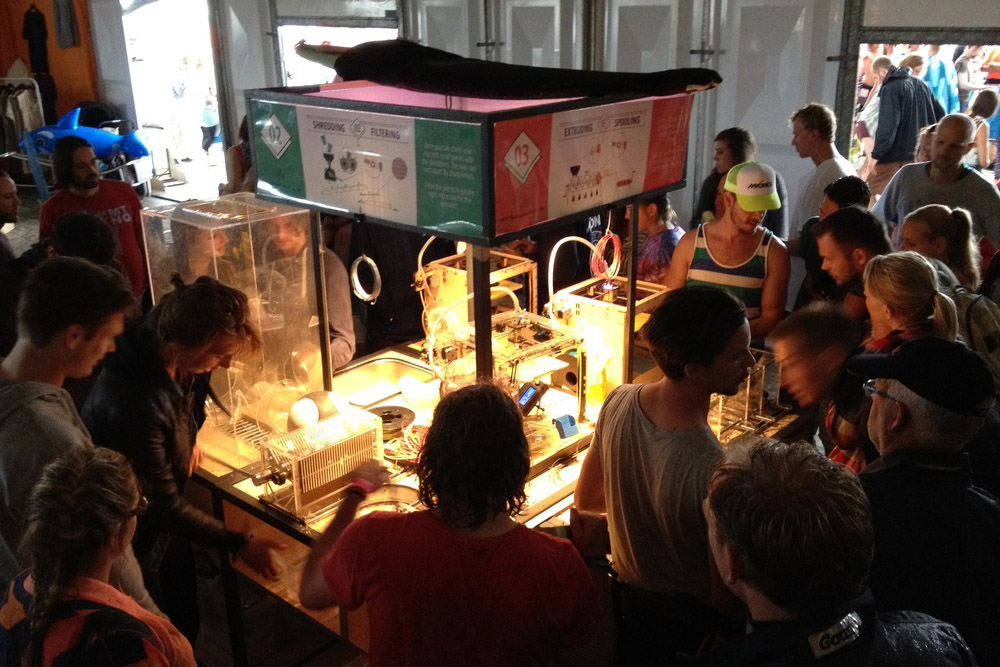This story originally aired September 30, 2016
Plastic pollution is all around us—from grocery bags blowing down the street to the islands of plastic floating in the oceans. But Bart Bleijerveld, an industrial designer from the Netherlands, sees plastic a little differently. He says it’s a really useful—even beautiful—material. We’re just using it the wrong way.
“It is designed to last for a really, really long time, while everybody’s using it as a disposable,” Bleijerveld says.
Bleijerveld was in Pittsburgh for the Living Products Expo, a showcase of sustainable products and design materials. That’s where he demonstrated the Perpetual Plastic Project, his company’s solution for the seemingly endless stream of plastic waste generated by modern life.
LISTEN: Conversation with Bart Bleijerveld
Bleijerveld drops an ordinary clear, plastic cup—the kind you’d use at a party and toss out—into a custom-made shredder with a manual crank. With a little elbow grease and a few turns, he ends up with confetti-sized pieces of plastic. He then places them into the extruder, a machine that heats the plastic up to 200 degrees and pumps the warm goo through a small hole—like toothpaste through a tube.
The end product is a long plastic wire that becomes the “ink” for 3D printers. The idea came to Bleijerveld and his colleagues a few years ago when they found out that the plastic waste at one of the Netherlands’ biggest festivals was a biodegradable plastic called PLA.
“I think there are about 50,000 people attending the festival,” Bleijerveld says. “And you can imagine if they all drank 10 beers a day, you end up with half a million empty cups you have to dispose of.”
It turns out PLA is also the most used plastic in making 3D printer ink.
“Everybody said it was not possible, but we proved them wrong.”

Better Future Factory’s Bart Bleijerveld. Photo: Kara Holsopple
Bleijerveld’s company, Better Future Factory, now uses an industrial-scale version of the Perpetual Plastic Project setup to make printer ink from old car dashboards and refrigerators.
For the demo in Pittsburgh, he feeds a spool of the recycled plastic filament through a 3D printer. It puts down fine, hair-like layers of melted plastic to create a shimmery, heart-shaped ring. While Bleijerveld says you can make just about anything on a 3D printer, the rings are part of a strategy at public events to draw in people of all ages so they can see how the Perpetual Plastic Project works.
“I love when little kids walk through the steps, and then one hour later they come back with their parents and they explain to their parents what the process is like. And that’s amazing.”
The Perpetual Plastic Project is based on the concept of the circular economy—a system engineered to produce no waste or pollution. Bleijerveld says the way he sees it, products should be made locally, on 3D printers, for example. That way, we could use a local waste stream, like plastic cups, to make new products without having to truck in materials or finished goods.
“We don’t need to transport products anymore, and we don’t need to transport waste anymore,” Bleijerveld says. “So we can create a local loop, a local circle.”
He says there are also other circles we can make, like reusing the products we already have, and repairing them when they’re broken.
“Especially with 3D printing, we can print replacement parts,” Bleijerveld says.
WATCH: Check out the Perpetual Plastic Project in Action
Bleijerveld says if you’ve ever used a 3D printer, you know that it’s slow and what you design in theory doesn’t always work out in practice. A lot of 3D printing projects end up in the trash. But that’s the advantage of starting with recycled plastic. As long as the plastic is of one type so it melts at the same temperature, it can be used over and over again.
“We like to look at it as Lego bricks. You can build a product, and if you don’t use it anymore, break it down into pieces and build up a new one.”

